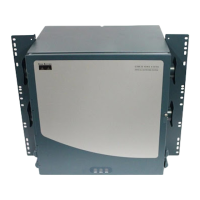6-45
Cisco ONS 15454 Procedure Guide, R5.0
August 2005
Chapter 6 Create Circuits and VT Tunnels
NTP-A295 Create a Manually Routed OC-N Circuit
Caution Circuits routed on BLSR protection channels are not protected and are preempted during BLSR
switches.
Step 13 If you selected Fully Protected Path in Step 12 and the circuit will be routed on a path protection, choose
one of the following:
• Nodal Diversity Required—Ensures that the primary and alternate paths within the path protection
portions of the complete circuit path are nodally diverse.
• Nodal Diversity Desired—Specifies that node diversity is preferred, but if node diversity is not
possible, CTC creates fiber-diverse paths for the path protection portion of the complete circuit path.
• Link Diversity Only—Specifies that only fiber-diverse primary and alternate paths for path
protection portions of the complete circuit path are needed. The paths might be node-diverse, but
CTC does not check for node diversity.
Step 14 If you selected Fully Protected Path in Step 12 and the circuit will be routed on a BLSR DRI or
path protection DRI, check the Dual Ring Interconnect check box.
Step 15 Click Next. In the Route Review/Edit area, node icons appear for you to route the circuit manually. If
you checked Dual Ring Interconnect for BLSR, continue with Step 16. If not, continue with Step 17.
Step 16 If you checked Dual Ring Interconnect in Step 14 for a BLSR DRI, complete the following substeps to
assign primary and secondary nodes.
a. In the Route/Review Edit area, click the BLSR-DRI Nodes tab.
b. Click Add BLSR DRI.
c. In the BLSR DRI Options dialog box, complete the following (for an example of a traditional and
integrated route on primary and secondary nodes, see Figure 6-12):
• Primary Node—For a traditional or integrated BLSR-DRI, choose the node where the circuit
interconnects the rings.
• Secondary Node—For a traditional or integrated BLSR-DRI, choose the secondary node for the
circuit to interconnect the rings. This route is used if the route on the primary node fails.
• Primary Node #2—For a traditional BLSR-DRI where two primary nodes are required to
interconnect rings, choose the second primary node.
• Secondary Node #2—For a traditional BLSR-DRI where two secondary nodes are required,
choose the second secondary node.
d. Click OK.
e. Review the circuit constraints. To change the circuit routing order, choose a node in the
Required Nodes/Lines lists and click the Up or Down buttons to change the circuit routing order.
Click Remove to remove a node or span.
f. Click the Included Spans tab, and continue with Step 17.

